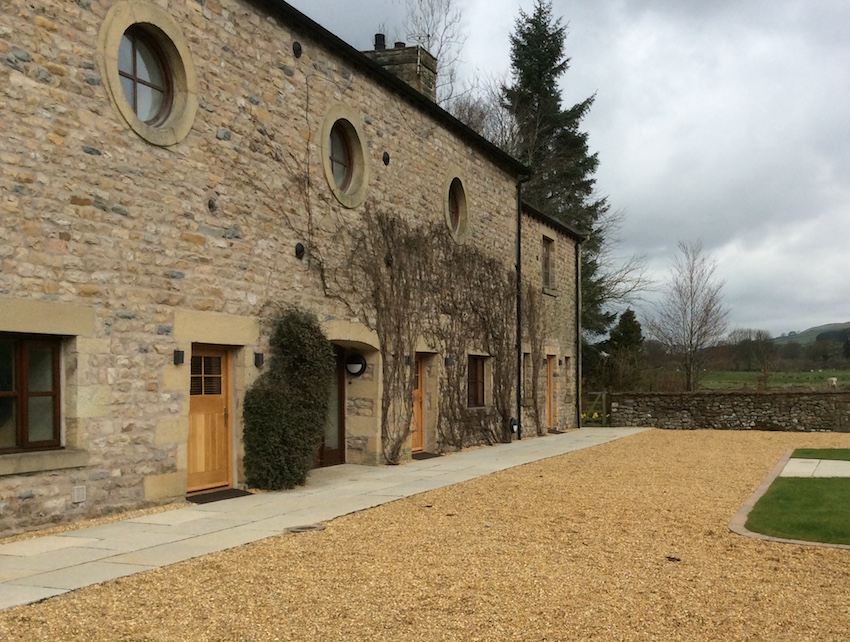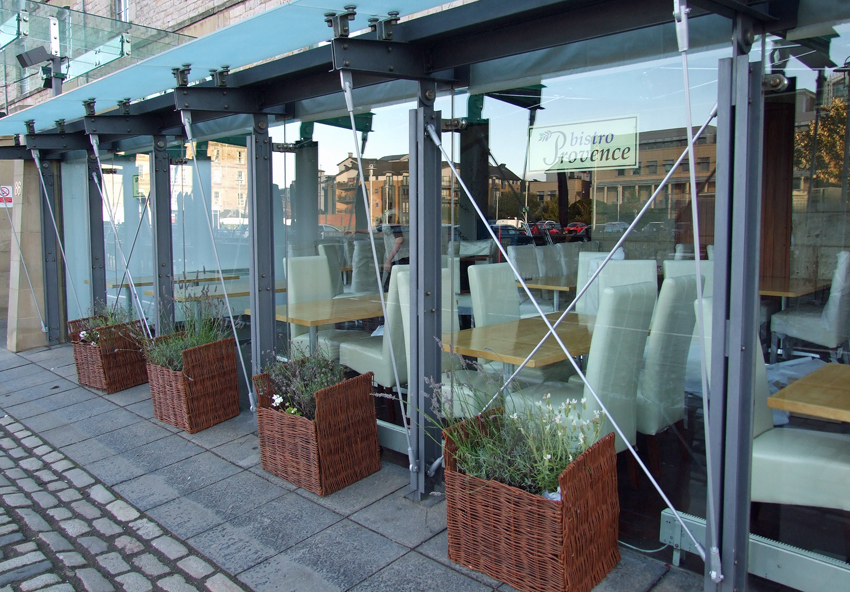This article comprises three elements: An interview with owner Andrew Wildsmith (Below at Forest Side), an interview with head chef Kevin Tickle and an extensive restaurant review of a signature tasting menu. Interviews took place in April 2016 and were conducted by Daniel Darwood, the food review is also by Daniel Darwood.

Andrew Wildsmith at Forest Side photo courtesy of Jenny Heyworth
Fine Dining Guide had the pleasure of interviewing Andrew Wildsmith at the award winning Forest Side in April, 2016. This hotelier extraordinaire embarked on his journey into hospitality almost by chance. After finishing his PhD in Chemistry at Cambridge, uncertainty regarding a long term career and the on line search for a house near his native Lancaster – he is an alumnus of Lancaster Royal Grammar School – resulted in the purchase of Hipping Hall. In his own words, “the joy of procrastination and the internet” combined like serendipity to launch him on a highly successful, if unanticipated, career.
Not that his interest in food was anything new; indeed the chemistry of food as well as the pleasures of the table were key interests amongst his student fraternity. Luckily, his deep love of food, wine and service was further nurtured by his two key advisers at Hipping. Running a hotel without any professional training, including acting as a barman and waiter, proved a steep yet valuable learning curve.
The logical thinking and organisation needed to see a scientific research project through has now been applied in his pursuit of excellence in the hospitality industry. Andrew’s personal qualities have also proved invaluable as he enjoys talking to staff and guests and is able to read people quickly, appreciating their individual needs. At the heart of his philosophy of hospitality is “discovering, exceeding and managing” the expectations of his guests. Seeing things from the customer’s point of view, especially in levels of pricing, is more important than mere accounting formulae.
Unlike many proprietors who remain anonymous and at arms-length, Andrew is fully immersed in all aspects of the hotel’s life, from the overall design concept to recruiting key staff. His priority in taking over Forest Side was to restore the bedrooms to their original size, as many had been split in two with false ceilings. Much of the design of the spectacular dining room was his own input. Indeed, Forest Side has seen considerable investment in its re-modelling as a high end country house hotel, with a hallmark of understated luxury and comfort.
Ideally, Andrew views each hotel as an “island” utilising the bounties of nature to be as self-sufficient as possible. The sourcing of local food and materials is fundamental. The development of a kitchen garden is also a high priority, hence the employment of two full time gardeners. The 46 acre forest in the hotel’s grounds gives ample opportunity for foraging. All the carpets are made from the wool of local Herdwick sheep, whilst the rustic wooden tables in the restaurant are made from the floorboards of the original dining room.
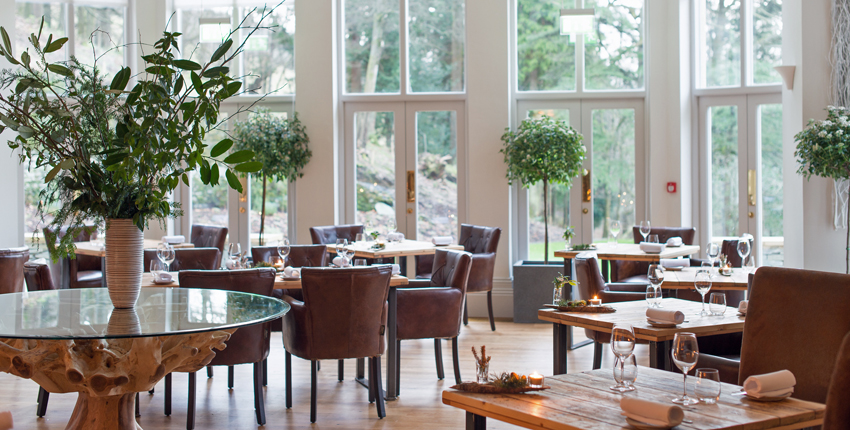
In relations with chefs, there has to be mutual respect even if there is an occasional healthy difference of opinion . It is important also that proprietors know how to cook, so they can liaise more effectively with chefs. A recent visit to Albert Adria’s Tickets restaurant in Barcelona revealed how food could also be fun and playful, which is evidenced in some of his own chefs’ dishes. Andrew loves being in the restaurant and kitchen, relishing the adrenalin rush of service. He not only dines in his hotels – he was hosting a lunch at Forest Side on the day of our visit – but may also help serve the guests, as witnessed during our meal at Hipping Hall.
With typical understatement Andrew says his proudest achievement at Forest Side is the “nice level of pleasure” it provides. Nevertheless, there was no denying his delight at achieving two awards after just two months of opening: Cumbria Life Food and Drink Awards: Best Newcomer and Hotel Restaurant of the Year. Positive reviews in the nationals and recent feedback from the AA have also been encouraging which bode well for the hotel’s prospects in the highly competitive market of luxury Lakeland hotels.

Head Chef Kevin Tickle was born and bred in Cumbria and has spent all his professional life in some of its most celebrated kitchens: Sharrow Bay, Gilpin Lodge and L’Enclume where he spent nine years, rising to sous chef for Simon Rogan. Lured from his positon as Head Chef at Rogan and Co. in Cartmel, he took up his current post.
A forager of the Cumbrian coast and forests since childhood, often with his friend now sous chef Martin Frickel, Kevin took up preserving, pickling, fermenting, curing and distilling to maximise the potential of his kitchen larder. The development of a kitchen garden has been essential to his style of cooking which demands the freshest of ingredients
Undoubtedly, Simon Rogan has been the biggest influence in terms of ethos and style of cookery. The focus on seasonality, regionality, sustainability, organic husbandry and self-sufficiency in the sourcing of materials and produce, with the added benefits of foraging, has produced in Kevin’s cooking’s a natural food style. The French might call it a Cumbrian cuisine terroir that captures the culinary essence of the Lake District.
With dishes having relatively few ingredients, the treatment of each has to be finely judged. Precision in timing, harmony of flavours, textural interest and clean presentation are key features of Kevin’s cooking. Foraged items appear as integral parts in most dishes, not mere decorative flourishes. He shuns fancy techniques in favour of classical skills. Presenting his food on regional stoneware, slate and wood also helps to encapsulate the Lakeland feel.
Options at dinner include a three course a la carte menu, ‘The reet l’al yan’; a six course tasting, ‘the l’al yan; and a ten course tasting menu, ‘The grand ‘un’. At lunch the ten course tasting is available alongside a four course set menu, “The bait” These give ample scope for Kevin’s creativity in which he is assisted by his brigade of 12, especially sous chef Martin Frickel.

Fine Dining Guide sampled the “The grand ‘un'” on a Friday evening in April.
Seductive cocktails were prepared by Bruno Vilas whilst Dion, the sommelier was on hand to advise on the all organic and biodynamic wine list. In the end were opted for the matching wine flight.
Two amuse bouches demonstrated the precision and invention evident throughout the menu. Celeriac cracker with apple puree and black pudding and Ruscombe cheese cracker with “snow” playfully teased the palate and eye.
A warm country loaf had crisp crust and exceptionally light crumb. We avoided with difficulty the temptation of eating too much which would reduce out capacity to tackle the ten courses to come
The first course featured tiny confit Jersey Royals that burst with creamy flavour. These were served with an oyster emulsion, tarragon oil, borage leaf, crispy pig’s ear and caviar. A small serving, this was a tantalising composition of contrasting textures, earthy and herbal flavours and humble and extravagant ingredients. Wine: Sottoriva, Malibran, Veneto, Italy.

Mild, sweet salt baked kohlrabi and soft, chewy surf clams worked well with the gentle saltiness of the seaweed broth poured at the table. Foraged scurvy grass and sea lettuce added a peppery dimension to this delicate, nourishing dish. Wine: Roditis, Jason Ligas, Pella, Greece, 2014 dry, fruity, delicate.
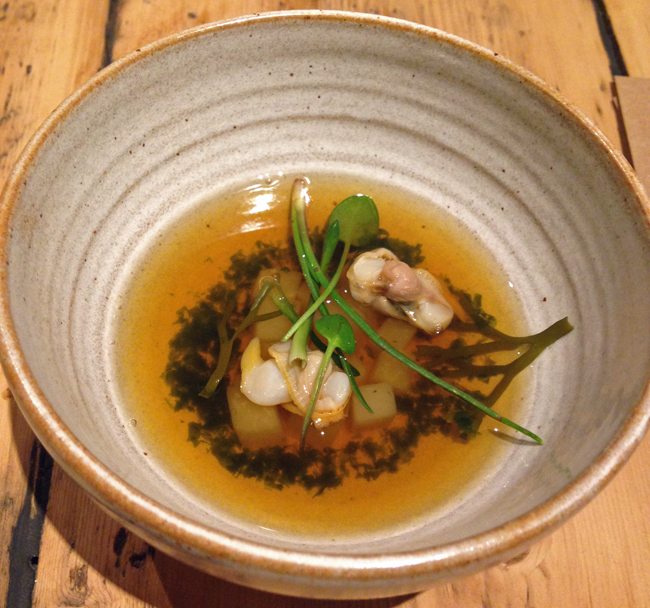
The next course played tricks with the eyes and taste buds. Venison Pastrami – the best I’ve ever tasted of any meat – had an enhanced gamey flavour. Enveloped by thinly sliced swede which looked like gruyere cheese, the nutty cheese flavour was in fact provided by shavings of cora linn made from ewe’s milk. Smoked juniper yoghurt which had a strong affinity with the venison acted as a creamy base and pickled allium flowers gave a zesty lift this intriguing dish needed.
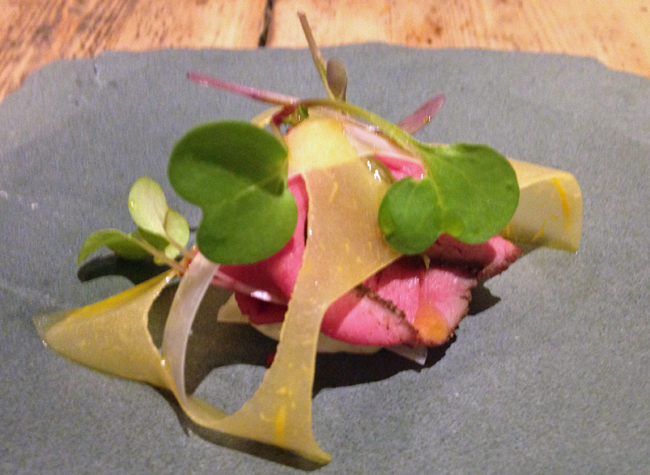
Additional theatre was provided by service at the table of homemade Forest Gin and Artemisia Tonic spiked with sea buckthorn jelly
Matching beverage: Forest Gin and Artemisia Tonic
Next, a fat hand dived West Coast scallop had a properly seared crust and soft, succulent flesh. Served with a transparent slice of “our Guanciale”, a home cured pig’s jowl, this could be seen as a playful take on the British classic scallops with bacon. New season’s green, and scorched white asparagus, gave bold and smoky notes, whilst the dish was bought together by a conifer Douglas fir consommé. Wine: Limney Estate, Horsemenden, Davenport, East Sussex, 2014 Dry white, aromatic.

The sweet and sour taste of pickled Pablo beetroot and its syrup worked well with the lactic notes of a creamy Ragstone cheese puree. Lemony fragrance was added by Sunset Velvet and hazelnuts gave crunch. Perhaps the most accomplished element on the plate was a delicate, curled sourdough crumpet, looking like paper thin melba toast with holes! The piney character of spruce pale ale, created by Catherine the head gardener in Forest Side’s own brewery, was an inspired matching beverage.

An accurately timed fillet of beautifully fresh line caught halibut had a caramelised crust and firm flakes of opaque flesh. Steamed mussels added a deeper flavour of the sea and soft dawn radishes, nasturtium leaves all and an oil from cuckoo flowers gave delicate peppery notes which complemented the mild flavour of this luxurious fish. Wine: Chablis, Cahteau de Beru, Burgundy, France dry white, mineral finish.

Next came a carnivorous show stopper. A piglet’s jowl (and cheek), cooked sous vide then finished on the plancha had a meltingly soft texture and unctuous porcine flavour. The super-thin crisp skin was the ultimate in delicate cracklings. Fennel pollen curd gave freshness to balance the richness of the meat. Celery and fennel stems added a slight aniseed note and birch sap – from the hotel’s own trees – save a muted sweetness. This was another innovative dish in which all the elements worked well together in an effusion of tastes, textures and temperatures. For pork lovers it was an orgasmic delight! Wine: Barolo, Sandri, Piemonte, Italia, 2008

Saving ourselves for dessert, we declined the offer of cheese but were impressed by the variety offered. Sourced from Courtyard Dairy in Settle, the all British and Irish selection were described in impressive detail by the young lady who served us.
A playful pre-dessert featured sheep’s milk ice cream, dehydrated frangipane, frozen rowan shoot, Sunset Velvet flower, and slow gin syrup, all combining to give the taste of Bakewell tart . The plum sake liqueur was another inspired if quirky pairing which seemed to emphasise the almond flavour. Matching beverage: Plum Sake liqueur, Umeshu, Amami-Oshima.

A dessert of scorched pear with spiced walnut cake, ginger beer jelly, beurre noisette cream, and malted tuile was a textural and taste delight, appealing to the eye as well as the palate. A technically demanding dessert, the combination of flavours worked well together, in particular the pear and ginger. Matching beverage: Homemade ginger beer

Textures of rhubarb featured the stems softly cooked sous vide, a silky smooth ice cream and an icy granita. A burnt butter tuile added a rich crispness and Sweet Cicely leaves gave a gentle aniseed flavour which enlivened the composition. A cocktail of rhubarb puree and Cremant de Loire was another harmonious match. Matching beverage: Rhubynni cocktail.

Delicious petit fours which ended the meal included fudge set in small pieces like bark on a forest floor, and Douglas fir Turkish delight on a litchen base.
In just two months the kitchen and restaurant at Forest Side are operating like a well-oiled machine, but one with personality and humour. The cheerful, informative and accommodating service is overseen by the engaging Joe Thomasin and his deputy Gareth Newton.
Overall, it is clear that Kevin and his team are firing on all cylinders, with strengths in all sections of the kitchen. The invention, precision and attention to detail sustain the diner’s interest and appetite throughout the tour de force of ten courses. Given this abundance of talent, perhaps it is not so surprising that Cumbria Life awarded Forest Side the Best Hotel Restaurant of the Year so quickly. But regional awards are the first step to national recognition which will inevitably come given the progress so far. Kevin Tickle cuisine is as accomplished as that of other Michelin starred chefs in the area and beyond, so it will only be a matter of time before he achieves equal recognition. The elite corps of Lakeland chefs now has a new member!

 Ruth Davies for Fine Dining Guide gives her impressions of Andrew Wildsmith ‘s third and most stylish hotel.
Ruth Davies for Fine Dining Guide gives her impressions of Andrew Wildsmith ‘s third and most stylish hotel.






















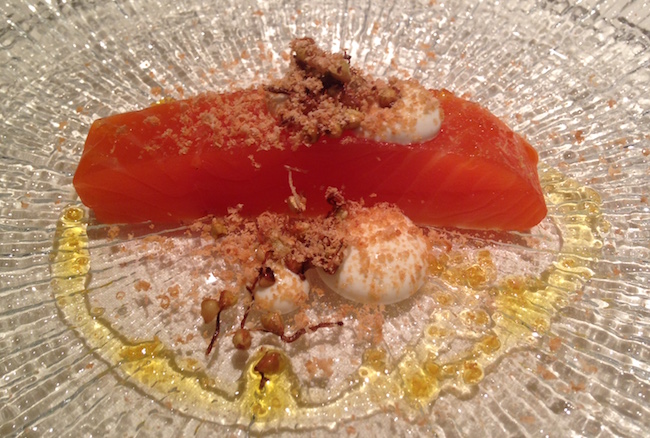




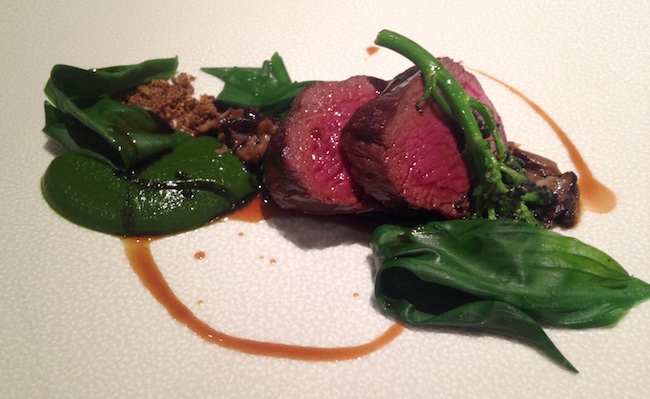



 Opened in 2005, Hipping was the first of three Wildsmith hotels, the others being The Ryebeck, which Andrew took over from his father, and the more recently acquired Forest Side, both in the Lake District. He opened Hipping without any experience of the hospitality industry and is largely self-taught. Learning on the job with the aid of trusted advisers has proved to be the most effective way of offering high quality accommodation, food and service. By 2010, so distinguished was Hipping’s reputation that the BBC chose it as one of five locations for the series The Trip, in which Steve Coogan and Rob Brydon reviewed restaurants in the north of England. Each course was turned four times in a six hour service for filming. Andrew remembers vividly how “intoxicating” two days’ of filming were, despite it being edited down to ten minutes for television.
Opened in 2005, Hipping was the first of three Wildsmith hotels, the others being The Ryebeck, which Andrew took over from his father, and the more recently acquired Forest Side, both in the Lake District. He opened Hipping without any experience of the hospitality industry and is largely self-taught. Learning on the job with the aid of trusted advisers has proved to be the most effective way of offering high quality accommodation, food and service. By 2010, so distinguished was Hipping’s reputation that the BBC chose it as one of five locations for the series The Trip, in which Steve Coogan and Rob Brydon reviewed restaurants in the north of England. Each course was turned four times in a six hour service for filming. Andrew remembers vividly how “intoxicating” two days’ of filming were, despite it being edited down to ten minutes for television.


